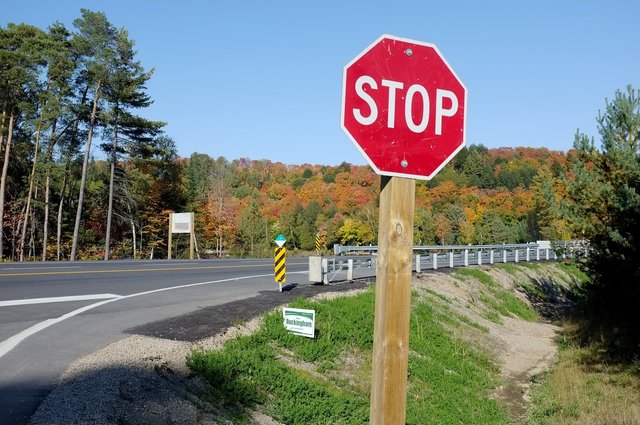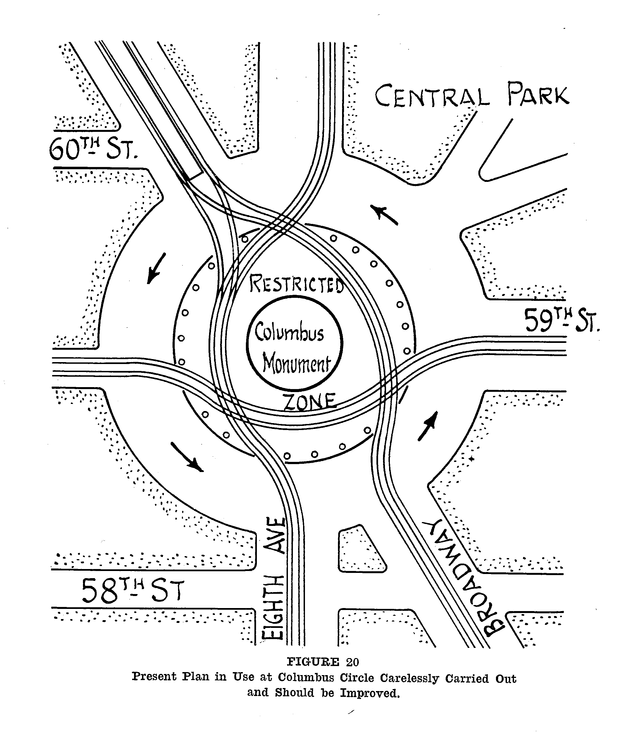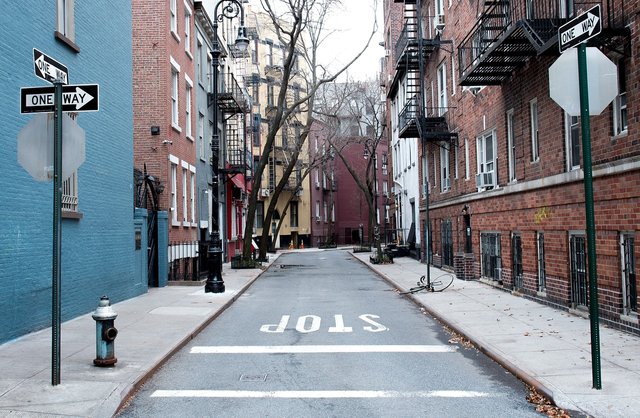Deep Thoughts About Stop Signs and Road Rules

My dog needed a walk and it was getting late. The kids had gone to sleep already and the dog was curled up on one of their beds. But I knew he might not make it until morning without having to go out. The best solution to this is to take him for a late walk before I go to bed, giving him the opportunity to do his business and not have to wake us up too early in the morning.
The ground was wet from recent rains. And there weren’t many cars when we went out. But of course, one came up just as we were crossing a nearby street. I’m sure the driver had the same thought I did: no one around except one person and (just my luck, of all the places he could have been) he had to be at that same intersection just when I got there. So the driver waited at a stop sign as my dog and I crossed via the crosswalk. I waved, of course, to let him know that I appreciated him pausing for a moment.
As the car passed behind us, its headlights lit up the stop sign on our side of the street. And that got me thinking about some weighty questions. Why are stop signs in the United States in the shape of an octagon? Why are they red? And for that matter, where did the stop sign come from? What about the crosswalk that allowed me, a pedestrian, to have the right of way in front of a car that must stop and let me pass first?
I’ve been at intersections in developing countries where a sign was painted on a rock. Still other intersections seem like pure chaos because there are no signs and the individual participants in the stream of traffic seem to operate however they wish. Whether they are in motorized vehicles, riding bicycles, or leading donkeys, there is no apparent organizing principle to the flow of traffic, aside from “the person with the biggest vehicle or who honks the most goes first.” Heaven help you if you’re just walking, since pedestrians don’t have the firepower to contend with bicycles or donkeys or honking trucks.

In 1874 in New York City, a 9-year old boy named William Phelps Eno was riding in a horse-drawn cart with his mother when they encountered a traffic jam. Later, an adult Eno wrote of it: "That very first traffic jam (many years before the motor car came into use) will always remain in my memory. There were only about a dozen horses and carriages involved, and all that was needed was a little order to keep the traffic moving. Yet nobody knew exactly what to do; neither the drivers nor the police knew anything about the control of traffic."
Traffic jams were quite common in large cities even before motor cars became widespread. Police did not have many rules to enforce, so they threatened drivers with their nightsticks and tried to keep the flow of animals and vehicles moving. By the year 1900, traffic jams (and even complete stoppages) were frequent in New York City, where it could take a delivery person the better part of a day to get from one part of the city to another.

By 1900, William Phelps Eno was a Yale University graduate and businessman in New York City. That year, he wrote an essay called Reform in Our Street Traffic Urgently Needed. He made the following three suggestions:
We must have concise, simple and just rules, easily understood, obeyed and enforced under legal enactment.
These rules must be so placed and circulated that there can be no excuse for not knowing them.
The police must be empowered and ordered to enforce them, and men should be trained for that purpose.
In 1903, Eno drafted the first traffic code for the city of New York. His traffic plans later were implemented in New York, Paris, and London.
Also in 1903, the New York City Police Department asked for a plan for Columbus Circle, a large chaotic mess that produced nearly one accident per day. With Eno’s help, the traffic circle was born. It was designed so that traffic flowed in one direction only, to the right in a counterclockwise flow. Several years later, the same plan was put into place at the Arc de Triomphe in Paris.

In 1909, Eno wrote a book called Street Traffic Regulation, which contained an image of his traffic circle at Columbus Circle in New York. The stop sign had eight sides. And stop signs were implemented in other cities later also. But it was not until 1923 that Mississippi’s highway department came up with the red, eight-sided stop sign that we know today in North America and beyond. Mississippi’s idea was that the number of sides could indicate the severity of a hazard; railway crossing would be round and stop signs would be just below them in the hierarchy with eight sides.
From a later publication from Eno, we also learned that he invented one-way streets. “On the author's advice, One-Way Traffic was put in force in a few streets in New York in the spring of 1908; in Boston in the autumn of the same year; in Paris in 1909, where it has since been greatly extended, and in Buenos Aires in 1910. It is now used in many cities throughout the world." The Science of Highway Traffic, 1899-1920.

Today, William Phelps Eno is known as the father of traffic safety (and regulations). He’s also known for having invented the stop sign, the one-way street, the traffic circle, the pedestrian crosswalk, the taxi stand, and pedestrian safety islands. All of these may not fit on his gravestone, but they do fit on his Wikipedia page. Fans of total chaos and anarchy may spit upon his grave, but modern safety and efficiency owe a great deal to Eno’s innovations, and I’ll be thanking him the next time I walk my dog across the street. The French government granted Eno its Legion of Honour award and an honorary driver’s license (see image below), even though he never learned to drive.

A copy of Eno's honorary driver's license from France.
References:
https://interestingengineering.com/the-real-reason-behind-why-stop-signs-are-red-and-octagonal
http://mentalfloss.com/article/56877/why-do-stop-signs-have-eight-sides
https://en.wikipedia.org/wiki/William_Phelps_Eno
Images are public domain or credited in the text.
First of all, on the roads, we must respect each other, and follow the rules, only then there will be order. Nowadays, to observe these rules is necessary for life. For example, I recently watched a young man cross the road at a red light of a pedestrian traffic light in front of a moving police car. The driver still managed to stop the car in time, but it was an emergency braking, which, in icy conditions, does not guarantee the safety of passengers and surrounding pedestrians if the car is taken away. It turns out that the violated young man created an emergency situation that could lead to the danger for many people.
Everything we do has effects on others.
I laughed my ass off at this point. :D
Hats down to this man, so much innovative thinking - it is just street regulations, but man to come up with all this - I always thought it was some "body of regulation" that came up with protocols and stuff.
Very interesting article, thanks!
Yes, I thought it must have taken many decades of development and many people. Probably did, but still one man in a short period of time is credited with developing much of it. Certain people have the right mindset for something and happen to be at the right time and place in history to make their mark.
My friend @donkeypong here are you how are you? asking you interesting questions, I am interested in knowing how things were created and the meaning of each things, there is always an answer for something for example the traffic signs each shape and color has a meaning right now I do not remember just read once about that
I am glad to know that it is your country to comply with the rules here in my country it does not matter much a traffic signal or a traffic light people are usually imprudent and there is nobody watching at home signal or traffic light to fine these people
@donkeypong, I never heard before how traffic signals or rode rules came around to the world. I know just now how was came to every states who attended to created first traffic rules William Phelps Eno. Absolutely his Reform in Our Street Traffic Urgently Needed essay could be important to created road rules I believe. Your mind very powerful coz you thinking different ways. That's really educational post for every peoples I recommend everyone need to read this.
Without make road signals and rules drivers cannot control always. Traffic police must need to take action if some driver break road rules. But some developing countries officers don't care who're break road rules. They try to take bribery from drivers. I saw many times it. William Phelps Eno did great task for make and control every countries traffic rules through his introduction. Thanks for the valuable post.
People must obey traffic rules and governments must find a way to address the traffic situation because it is detrimental to the economy. @donkeypong
True. It doesn't help the economy when people are stuck in traffic much of the time or getting in accidents.
Having sat in Southern California traffic, traffic flow often at a crawl, I've taken a mild interest in the subject as well. I think the problem here no longer has to do with traffic regulations, the design of the roads, or the behavior of drivers, but has to do with capacity. Some form of mass transit would be far superior than an 8-lane (in one direction) highway with so many people in cars trying to use it at the same time, that literally, nobody can move faster than a walking pace. I think self-driving cars or very skilled driving habits from people could alleviate some of the problem, but unless the number of cars is reduced in some way, traffic will still become congested in this part of the country on a daily basis. Only so many cars can fit through this bottleneck at one time.
That's correct. Even an 8-lane freeway was not built to accommodate the population we now have in larger metro areas like LA. Self driving will help somewhat, but not fix the problem. We need a lot of mass transit.
The truth is that I do not know much about traffic signals I saw them in school in a book but I still do not learn to drive so I do not know what all the traffic signs mean
You ask interesting questions I ask myself questions how are you every day I want to know where things come from, because they have that shape and where they created it so I think a lot and I think I'm crazy hahaha there is always someone exemplary that created those things, before people were very smart
Happy new year @donkeypong a few days ago that did not happen here
Hello my friend @donkeypong how are you doing? happy New Year for you
Curious theme and also educational, the traffic signals are as important as each created thing, who knows where those people are born with those thoughts of creating things to me I could not imagine creating a traffic signal, a letter, etc.
I think the developed countries have that good that traffic signals are met and you can find them in different ways, I believe that today without traffic signals this would be a disaster
Interesting history of traffic control in America, I would be interested to see how it compares in Australia. Here most of the roads were started as cattle trails and for logging carts before automobiles came into being. We have the same stop signs here as well by the way, maybe they are universal in all countries now.
Yes, the signs seem fairly similar in a lot of places. Stop and yield to the cows (or sheep in NZ)!
You made me remember this amusing video from an intersection close to my home in Crete, Greece :)
https://www.youtube.com/watch?time_continue=52&v=GyekOWbsHVk
That is great, wow. They look like ants or something!